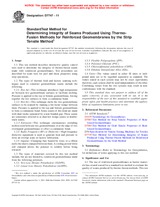Potřebujeme váš souhlas k využití jednotlivých dat, aby se vám mimo jiné mohly ukazovat informace týkající se vašich zájmů. Souhlas udělíte kliknutím na tlačítko „OK“.
ASTM D7747-11
Standard Test Method for Determining Integrity of Seams Produced Using Thermo-Fusion Methods for Reinforced Geomembranes by the Strip Tensile Method
Automaticky přeložený název:
Standardní zkušební metoda pro stanovení integrity švy vyrobeny s použitím metod Thermo - Fusion vyztuženého geomembrány páskem v tahu Metoda
NORMA vydána dne 1.10.2011
Informace o normě:
Označení normy: ASTM D7747-11
Poznámka: NEPLATNÁ
Datum vydání normy: 1.10.2011
Kód zboží: NS-39053
Počet stran: 6
Přibližná hmotnost: 18 g (0.04 liber)
Země: Americká technická norma
Kategorie: Technické normy ASTM
Anotace textu normy ASTM D7747-11 :
Keywords:
ICS Number Code 59.080.70 (Geotextiles)
Doplňující informace
| Significance and Use | ||||||||||
|
The use of reinforced geomembranes as barrier materials has created a need for a standard test method to evaluate the quality of seams produced by thermo-fusion methods. This test method is used for quality control purposes and is intended to provide quality control and quality assurance personnel with data to evaluate seam quality. This standard arose from the need for a destructive test method for evaluating seams of reinforced geomembranes. Standards written for destructive testing of nonreinforced geomembranes do not include all Break Codes (figure 4) applicable to reinforced geomembranes. When reinforcement occurs in directions other than machine and cross machine, scrim are cut at specimen edges, generally lowering results. To partially compensate for this, testing can be performed according to , or the 2 in. wide strip specimen specified in this method can be utilized. Testing of 1 in. and 2 in. specimens is Method A and method B respectively. The shear test outlined in this method correlates to strength of parent material measured according to ASTM only if reinforcement is parallel to TD. For other materials, seam strength and parent material strength can be compared through and . Values obtained with the strip methods shall not be compared to values obtained with grab methods. |
||||||||||
| 1. Scope | ||||||||||
|
1.1 This test method describes destructive quality control tests used to determine the integrity of thermo-fusion seams made with reinforced geomembranes. Test procedures are described for seam tests for peel and shear properties using strip specimens. 1.2 The types of thermal field and factory seaming techniques used to construct geomembrane seams include the following. 1.2.1 Hot Air—This technique introduces high-temperature air between two geomembrane surfaces to facilitate melting. Pressure is applied to the top or bottom geomembrane, forcing together the two surfaces to form a continuous bond. 1.2.2 Hot Air—This technique melts the two geomembrane surfaces to be seamed by running a hot metal wedge between them. Pressure is applied to the top and bottom geomembrane to form a continuous bond. Some seams of this kind are made with dual tracks separated by a non-bonded gap. These seams are sometimes referred to as dual hot wedge seams or double-track seams. 1.2.3 Extrusion—This technique encompasses extruding molten resin between two geomembranes or at the edge of two overlapped geomembranes to effect a continuous bond. 1.2.4 Radio Frequency (RF) or Dielectric—High frequency dielectric equipment is used to generate heat and pressure to form an overlap seam in factory fabrication. 1.2.5 Impulse—Clamping bars heated by wires or a ribbon melts the sheets clamped between them. A cooling period while still clamped allows the polymer to solidify before being released. 1.3 The types of materials covered by this test method include, but are not limited to, reinforced geomembranes made from the following polymers. 1.3.1 Very Low Density Polyethylene (VLDPE). 1.3.2 Linear Low Density Polyethylene (LLDPE). 1.3.3 Flexible Polypropylene (fPP). 1.3.4 Polyvinyl Chloride (PVC). 1.3.5 Chlorosulfonated polyethylene (CSPE). 1.3.6 Ethylene Interpolymer Alloy (EIA). 1.4 Units—The values stated in either SI units or inch-pound units are to be regarded separately as standard. The values stated in each system may not be exact equivalents; therefore, each system shall be used independently of the other. Combining values from the two systems may result in non-conformance with the standard. 1.5 This standard does not purport to address all of the safety concerns, if any, associated with its use. It is the responsibility of the user of this standard to establish appropriate safety and health practices and determine the applicability of regulatory limitations prior to use. |
||||||||||
| 2. Referenced Documents | ||||||||||
|
Odebírejte informace o nově vydaných normách ZDARMA:
Chcete pravidelně odebírat informace o nově vycházejících normách z celého světa a to zcela zdarma?
Přihlašte se k odběru. Vše je velice jednoduché a absolutně ZDARMA.
Na výběr máte vydavatele z celého světa.




 Cookies
Cookies
